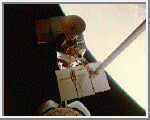
USA Solar Mission
Courtesy of NASA's National Space Science Data Center
The Solar Maximum Mission (SMM) was designed to provide coordinated observations of solar activity, in particular solar flares, during a period of maximum solar activity. The payload was made up of seven instruments, specifically selected to study the short-wavelength and coronal manifestations of flares. Data were obtained on the storage and release of flare energy, particle acceleration, formation of hot plasma, and mass ejection. Complementary studies were made as part of the SMM guest investigator program, and coordinated in situ measurements of flare particle emissions were made from the ISEE 3 spacecraft. The spacecraft was launched on February 14, 1980.
The SMM observatory was of modular construction and measured approximately 4 meters in length, fitting into a circular envelope 2.3 meters in diameter. The instrument module occupied the top 2.3 meters and contained all the solar payload instruments together with the fine-pointing Sun-sensor system. Below the instrument module was the Multimission Modular Spacecraft (MMS) containing the systems for attitude control, power, communication, and data handling. Between the instrument module and the MMS was the transition adaptor, supporting two fixed solar paddles that supplied between 1500 and 3000 W of power.
Quick and coordinated responses to solar flares were considered essential for meeting the scientific objectives of the mission. Therefore, the ground system was designed to facilitate coordinated data evaluation, observation, planning, and command uplink to the on-board stored command processor. On-board coordination of response to a flare was performed in real time. The attitude control software allowed observatory repointings and slow scanning motions. There was also a special module for tracking a solar feature over many days.
The spacecraft suffered an in-orbit failure. A repair mission on STS-41C in 1984, during which shuttle astronauts rendezvoused with SMM, was successful. SMM collected data until November 24, 1989, and re-entered on December 2, 1989.